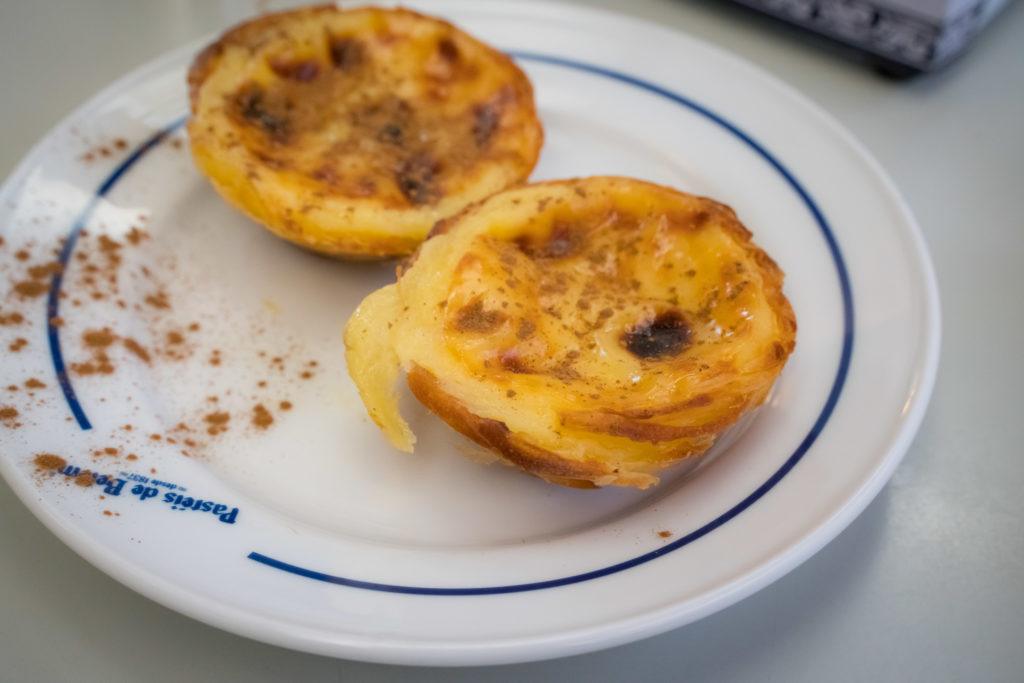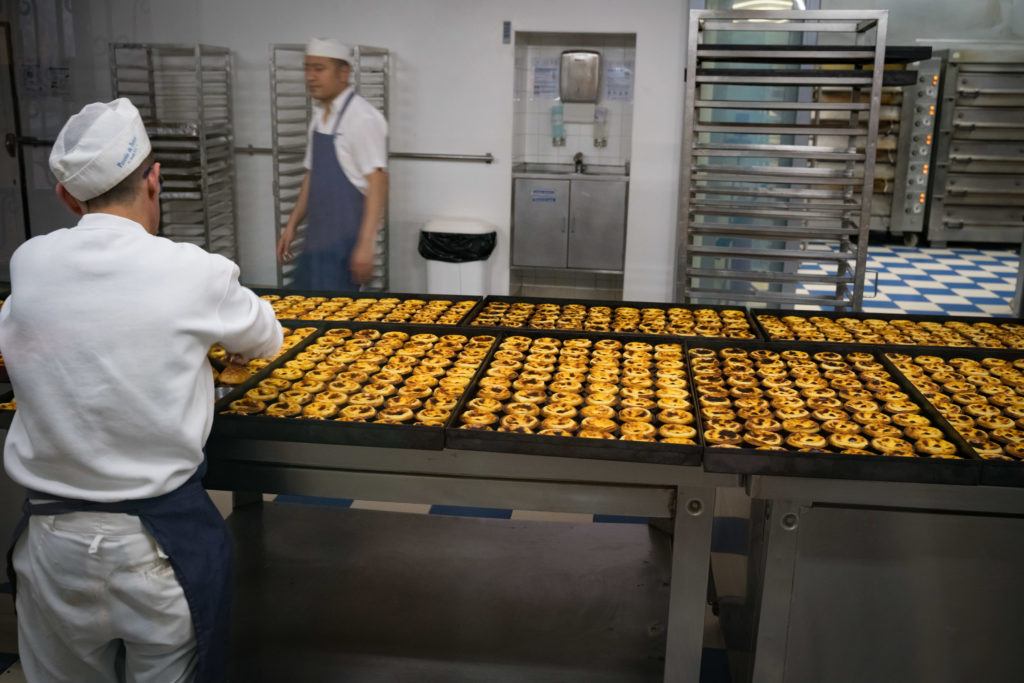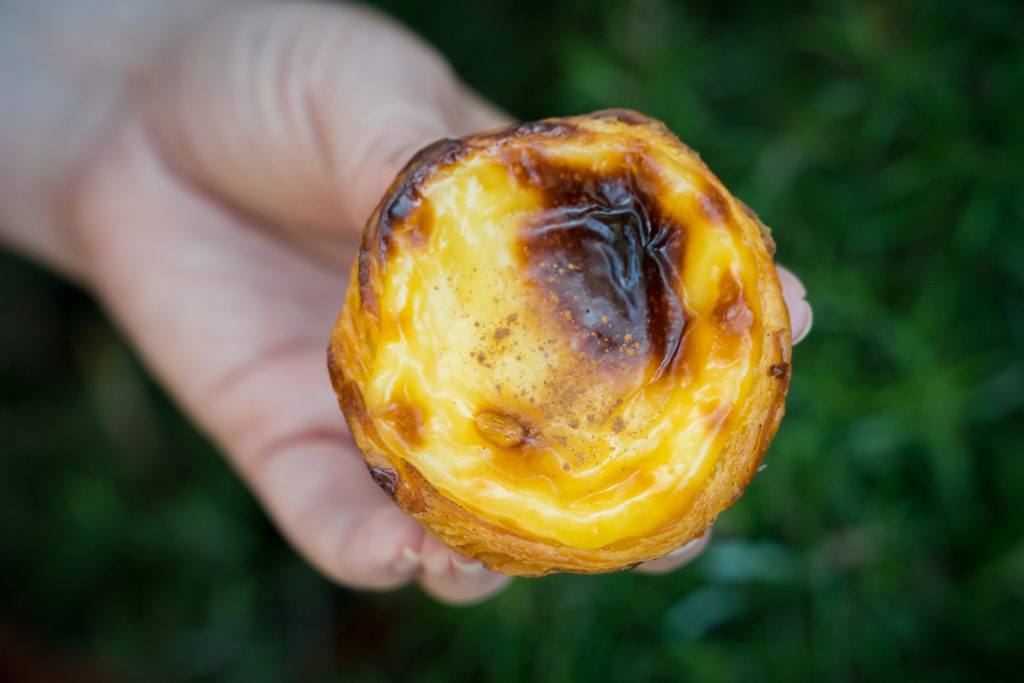Egg Tart History: In this article & podcast we explore the history of the Egg Custard tart, and it’s famous Portuguese counterpart, the Pastéis de Nata (Cream Pastry). Who invented the egg tart? Was Portugal first, or did someone else beat them to it?
We also look at egg tarts around Asia – are they based on European egg tarts? Or did they evolve independently?
Egg Tart History Podcast (S2E22)
In This Episode:
- Pastéis de Nata – Egg custard tarts – are they Portuguese in origin, or were they first invented elsewhere?
- Why the Portuguese egg tart is the culinary symbol of Macau, and the surprising story behind how it got there.
- Plus where can you eat the tastiest egg tarts? After a lot of testing, we think we’ve found them.
Listen & Subscribe For More Episodes:

Listen & Subscribe: iTunes | Spotify | Google Play | Stitcher
RSS: https://feeds.captivate.fm/thedish/
Support: Become a Patron | Tweet: @foodfuntravel | Email: [email protected]
THE BELOW CONTENT IS A PARTIAL TRANSCRIPT. IT HAS NOT BEEN FULLY EDITED FOR GRAMMAR.
Egg Tart History Partial Transcript (Unedited)
Today we are talking about Egg custard tarts. One of the most famous types of egg tart is the Pasteis de nata. The portuguese egg tart which features a sweet egg custard in a puff pastry shell.
But, though it may be world famous, was it the original egg tart? We are going to investigate.
Also in this episode we’ll be talking about how the Portuguese egg tart became so popular as well as looking at many other egg tarts from around the world.
First, a simple definition. What is an Egg tart. It has to have a sweet, cooked custard made with egg in the middle, and it has to have a pastry shell. That’s about it. Easy.
Before we get started, just a quick reminder, please subscribe to this podcast – that helps us let platforms know people are listening, which boosts our rankings. Also, recommend us to a friend – help us get our name out there!
First, let’s talk about how the Portuguese egg tart – pasteis de nata – was first created…
Egg Tart History (Pastéis de Belem) Lisbon
The exact invention date of the first pasteis de nata is unclear, though most sources believe it was being made from at least about 300 years ago. So sometime after 1700, probably.
In the monasteries of Portugal at the time, egg white was used to starch clothes during the laundry process. This left a huge supply of leftover egg yolks. Along with growing availability of sugar from the new world, coming straight to Lisbon from the colonies, Egg custard tarts were the perfect way to use up those egg yolks.
Monks, with time on their hands, set about creating a recipe. It’s unclear at this time if they sold them to the community, or just got fat eating them themselves.
Some sources claim this practice became popular in many monasteries. Others are pretty clear that the epicentre of this was at Jeronimos monastery in Belem, close to Lisbon.
In 1820, after the liberal revolution, government funding for monasteries ceased. Many convents and monasteries would close, and by 1834 they were all forcibly shut down. At some point between 1820 and 1834 monks from Jeronimos monastery definitely began to sell the egg tarts in order to make money to endure.
What happened next seems to be slightly contentious. There was a sugar refinery just over the road from the monastery, and a small general store attached to it.
Some sources say that the monks kept making the egg tarts and would sell them in the general store. Others claim they sold the recipe to the sugar refinery, who in 1837 opened the Fábrica de Pastéis de Belém, the bakery still there today. Some sources even suggest that some of the monks went into business with the refinery in order to open the bakery.
At the time, Belem was considered quite a way from Lisbon, it’s a couple of hours walk. Steamships used to bring daytrippers along the coast to marvel at the torre de Belem – the tower on the water there, and to see Jeronimos monastery, as the architecture is fantastic.
A pastry shop right next door had great potential and the Fábrica de Pastéis de Belém was a roaring success. Today the egg tarts are made from the same secret recipe from the monks of Belem all those years ago, only 3 people in the factory today know the recipe, it’s that much of a secret…
Today, they make over 20,000 pastéis de nata daily and tourists and locals flock their for a sugary hit. We dropped by to see if the originals really are the best…
[LIVE AUDIO CLIP – Us describing the Belem shop and egg tart]
So, a good egg tart with some serious historic pedigree – but not our favourite. What is the best egg tart in Portugal, or even in the world? More on that later in this episode.
One more aside – is it Pastéis de nata or Pastel de Nata? It means cream pastry – even though it is made from milk, egg yolk and sugar, not cream. But it is creamy! Pastel de nata is the singular – for one pastry. Pasteis is the plural, which is the quantity of egg tarts I prefer to order. Of course, in belem, they are called pasteis de belem, specifically. Imitations appeared all over the country, then the world from there.
So, Portuguese monasteries may have been making egg tarts since at least 1700. But did they invent them?
The Original Egg Tarts – Before Portugal
It seems likely that egg custard in a pastry case was being made and eaten long before 1700. The strongest candidates for creating them first are the English and the French.
In England, they are called custard tarts. The English word Custard likely comes from the french word Croustade, which is a type of pie. Written documentation for something akin to a modern custard tart exists from 1399 where they were prepared for Henry IV coronation banquet.
These original pastries were called doucettys or doucettes which referred to a sweet dessert. Recipes indicate it would be made with egg, milk and honey.
The word doucettys also derives from French, from the word doux, which means sweet. Of course, the etymological connection doesn’t prove France was making these foods before England, as lots of words in England come from French as they conquered England in 1066…
So, once again as in so many episodes of The Dish, simply the fact that England had an insatiable need to write things down, it seems like they are going to win the race for original egg custard tart.
However, there are some differences. British egg tarts would typically feature shortcrust pastry, not puff pastry. They use nutmeg, rather than cinnamon. Also, british ones are cooked slowly, letting the custard go firm without caramelizing on top. They are often served cold too. The biggest difference was the original egg tarts were not little individual pies, they were likely full size pies.
In fact, in the court of Queen Elizabeth the 1st, back in the 16th century, it’s documented that her cooks made egg tarts so big that her court jester could dance in them – some proto version of custard wrestling likely followed. Probably without bikinis, Liz was a classy lady.
When did England start making the small individual pastries? That is unclear, but custard tarts in general, seem to have their earliest evidence in the UK.
Egg tarts in China & The world spread of egg tarts
Egg tarts have since become a favourite all over the world. Portuguese egg tarts made it to Japan a long while back.
Egg tarts are massively popular in both Hong Kong and Macau, both Chinese territories. In Hong kong, the short pastry English style, and in Macau, the Portuguese puff pastry style. As Hong Kong was British and Macau used to be Portuguese, you’d assume that it was those nations that popularised the egg tarts their… But the story is not quite that simple.
Let’s start with egg tarts in Hong kong. These might actually be my favourite egg tarts. The number one trick to make a tastebud punching egg tart is shortcrust pastry with lard! Oh yes, pork fat in the pastry makes them soooo much more pleasing than without.
What about the history. It appears the Hong Kong egg tart originated in the nearby mainland city of Guangzhou. Also a big trading port with European settlers and traders coming through regularly. It sits about the same distance from both Macau and Hong Kong.
The one vital ingredient for Portuguese style egg tarts is butter for the puff pastry. It just wasn’t a practical ingredient – it was too expensive to get in Guangzhou. This is why lard was substituted. Because of this, its unclear if the choice of short crust pastry was due to British influence, or simply necessity. but, the cantonese word for egg tarts is daan tat – which literally translates as egg tart, not cream pastry, which would be closer to the Portuguese name. Also, they have the smooth non-caramelized top, more like the british style.
The hearsay that they may have derived from the portuguese style, just doesn’t quite fit.
By the 1930’s, egg tarts had supposedly become a common dessert in Guangzhou – some sources claim a restaurateur there first adapted the recipe with lard in 1927 and it became a typical dim sum dish. By the 1940s and 50’s the adapted version had made its way to fancy cafes in Hong Kong and eventually became a budget snack for the people.
As well as lard, another improvement was they served them warm, rather than the English way of cold. Was this the Portuguese influence?
Let’s look at egg tarts in Macau and find out.
The first Portuguese settlement in Macau was established in 1557. Colonial rule began in 1849 and ended in 1999. Similar to Hong Kong. So when do you think Portuguese egg tarts first became popular in Macau?
1989
Until 1989, the only egg tarts in Macau were the same dim sum style ones that were first popularised in Guangzhou. So, the Portuguese egg tart, a popular symbol of Macau today, was actually the british/chinese style until then.
So, Macau, still a Portuguese colony in 1989, suddenly saw the arrival of the Pasteis de Nata, and from which country do you reckon the person who introduced them came from?
England.
A british pharmacist called Andrew Stow had been living in Macau since 1979. In the 80’s he took a trip to Portugal and tasted the Pasteis de Nata for the first time. He loved it and wondered why a Portuguese colony didn’t have this traditional food. After returning to Macau, he opened Lord Stow’s Bakery in Coloane Village in 1989 with the intent of supplying baked goods, including the pasteis de nata, to supermarkets.
But, because the local Chinese community was already used to egg tarts with dim sum, the Portuguese version became an instant hit! Today, Lord Stow’s bakery makes over 13,000 a day.
But, Lord Andrew Stow is not a lord. The name actually arose because, prior to getting into the bakery business, Andrew had tried to open a health food store – about 20 years before anyone in China would be interested in that sort of thing. The business struggled and so he took on a side job at night as the manager of the Green parrot disco at the Hyatt Regency.
As the boss, he apparently lorded it over his employees and everyone started calling him lord Stow. The name stuck. And it was such a popular name that copycat chains selling pasteis de nata started opening in Hong Kong, Singapore and Taiwan with the same name and even using Andrew’s photo illegally to promote their shops!
So, Portuguese egg tarts, a culinary symbol of Macau, popularised by a British guy since only 1989. Crazy!
What makes the best egg tart??
So, finally on this episode – what makes the best egg tart or pasteis de nata? And where can you find the best egg tart?
We took a food tour with the company withlocals.com in Lisbon, and our guide Lucian introduced us to the best portuguese style egg tart we’ve ever had…
[CLIP Mantegeria shop in Lisbon]
Being Warm! Custard not too eggy so they don’t want to taste like an omelette in pastry.
Soft, lardy pastry – or The perfect crisp puff pastry crust. A little bit of extra salt in the pastry helps with that apparently. Or, a butter soft and flaky puff – had a great one of those in Lisbon too.
Where To Eat Egg Tarts
In Lisbon:
Mantegeria (Best sweet and warm pastéis de nata in Lisbon)
Fabrica de Pastéis de Belem (Most Famous, original Lisbon egg tarts from 1830’s)
Hong Kong:
Tai Cheong Bakery Hong Kong(Lardy Pastry) – Very good, though not the best in Hong Kong, which were purchased for us by a friend from a now unknown location :-(
Macau:
Lord Stow’s Bakery, Macau – Portuguese style in Macau, original 1989 shop








